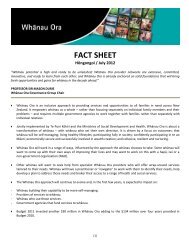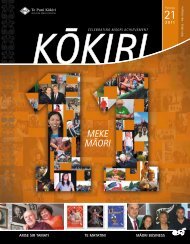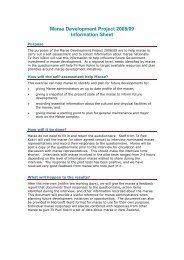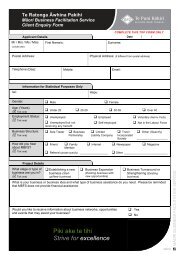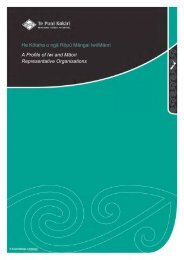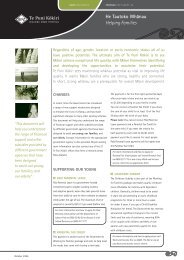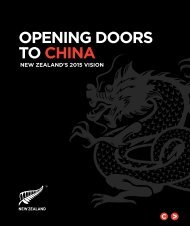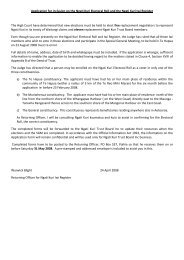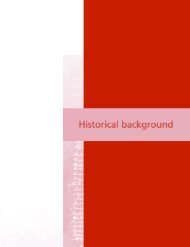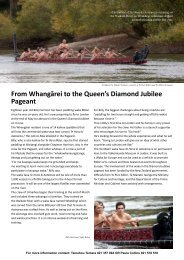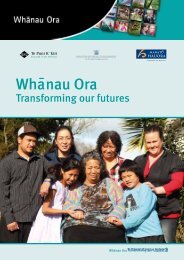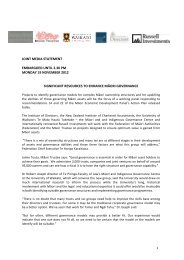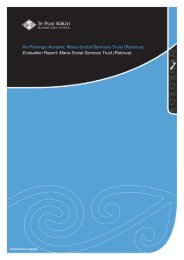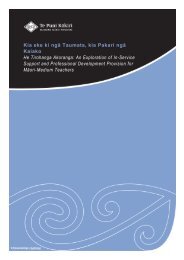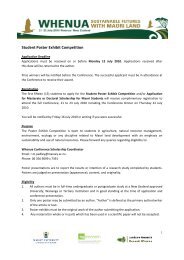He Oranga Hapori: A model for raising Maori ... - Te Puni Kokiri
He Oranga Hapori: A model for raising Maori ... - Te Puni Kokiri
He Oranga Hapori: A model for raising Maori ... - Te Puni Kokiri
- No tags were found...
Create successful ePaper yourself
Turn your PDF publications into a flip-book with our unique Google optimized e-Paper software.
Kapiti and Horowhenua profileIn the combined districts of Kapiti and Horowhenua there are five Iwi including Ngäti Tukorehe,Muaüpoko, <strong>Te</strong> Ati Awa ki Whakarongotai, Ngäti Toarangatira and Ngäti Raukawa. The latterthree make up a Confederation of three Iwi 41 and have <strong>for</strong>mal relationships with groups includingthe Kapiti Coast District Council. In addition to the Kapiti Coast District Council, this communityis served by the Horowhenua District Council to the north. The combined Iwi areas cross allboundaries; their takiwä extend from Manawatu in the north to Porirua in the south; and theiractivities are influenced by five district councils and two regional councils.Planned tikanga and results - Five strands of <strong>Te</strong> AhoInitially, five indicators of wellbeing were developed under five priority areas or strands; thetikanga that have been implemented to give expression to these priorities are also listed.1. Developing Whänau – Whänau are the core of Mäori society and are crucial change agents<strong>for</strong> positive Mäori development. An Iwi <strong>for</strong>um is charged with progressing this strand, twoimportant tikanga implemented by this group to celebrate whakapapa and whanaungatangainclude:• Developing a Kaumätua Forum with over 70 members to provide guidance to <strong>Te</strong> Aho. Thegroup meets quarterly. The Ngäti Raukawa kaumätua hosted the senior leadership of theMäori Party and the National Party including the Prime Minister at Raukawa Marae.• Working together to develop a Whänau programme based on a kaupapa and tikangaframework.2. Enhancing Skills – Skills are vital to successful Mäori economic trans<strong>for</strong>mation; increasinglydetermining the nation’s ability to grow economically. Examples of the tikanga developedby a group of Mäori businesses, organisations and institutions with an interest in education(compulsory and tertiary) include:• Provider packages where the group developed pathways <strong>for</strong> learning <strong>for</strong> their studentsand staff from Level 1 to Level 7 degrees within the region.• A Mäori Literacy and Numeracy programme <strong>for</strong> students was developed by and piloted bya member of our provider group.• Our People, Our Future Summit – held on the 1st & 2nd September 2009 where 160attendees contributed.• Our People, Our Future, Our Way Summit - held 16th June 2010 where 70 participantsattended.41 The Dominion Post, April 19, 2010, p-A7.42 Appendix 6 - <strong>Te</strong> Aho Quarterly Report.43 One or more of the ten that <strong>Te</strong> Wänanga oRaukawa has been working with.3. Strengthening Relationships – Meaningful relationships need to be built that acceptdiversity; have long term commitment and are nurtured. Responsibility <strong>for</strong> giving expressionto kotahitanga and rangatiratanga in this strand is shared by all groups involved in <strong>Te</strong> Aho.• Iwi are collaborating on economic development strategies including Whänau Oraprogrammes.• <strong>Te</strong>rtiary education providers are working together.• There is increased participation by Mäori with industry groups and local government.• Relationships with both Councils are improved.• Development of processes <strong>for</strong> Mäori submissions to LTCCP. 42• Regular and in<strong>for</strong>mal breakfasts with the two mayors.• Council attendances to Huihuinga. 4326



